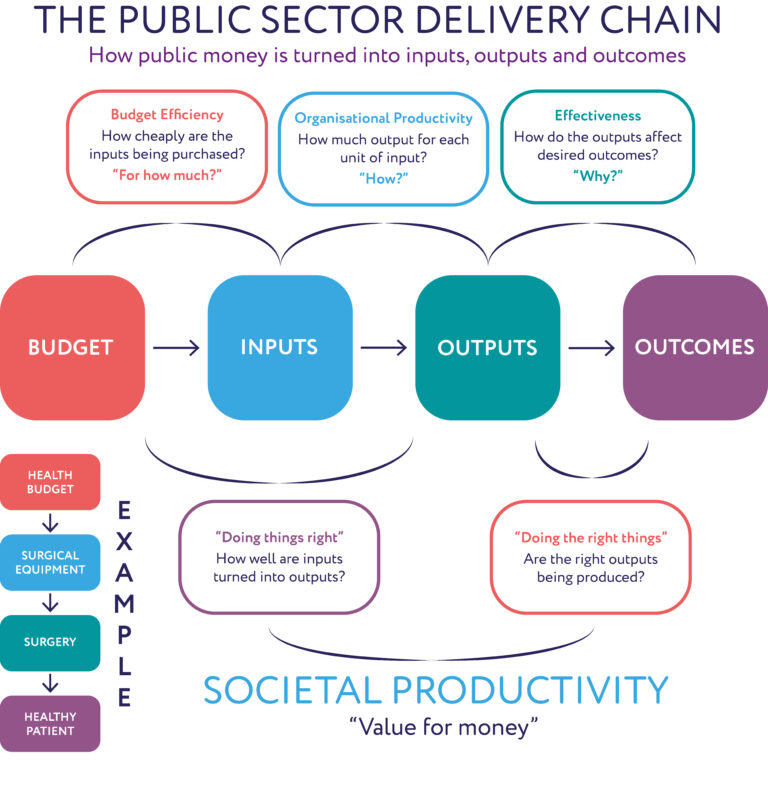Can public services improve their productivity without new funding?
In times of significant economic and societal challenges, the public sector plays a critical role. Public services are essential for ensuring people’s health and well-being, paving the way for economic recovery, and rekindling sustained economic development and improvements in living standards across the country.
Yet the pressure on the resources of many public sector organisations has become almost unbearable for the sector’s staff and users – which is all of us. The challenges posed by post-COVID-19 pent up demand and staff shortages are felt across the sector, including education, health care, social care, and local government. Post-Brexit measures are also adding to the pressure on many national government agencies, including those dealing with trade, transport, migration and taxation. The economic headwinds we are facing both increase the need for an agile and resilient public sector and create new risks and pressures because of the looming threat of tighter budgets and burned-out staff.
Is there a path out of this situation? There is no doubt that adequate funding is a pre-condition for high-performance public services, and many services have experienced years of funding pressure. But that statement is laden with strong underlying assumptions, in particular that we know what “adequate funding” and “high performance” mean. But this is not obvious. We need to understand better what makes the public sector perform well and how it can be best enabled to do so.
In a new report by The Productivity Institute, we argue that productivity growth in the public sector is key to improving service delivery. Improved public sector productivity has been proven to provide large benefits to society, not only by using scarce public resources more efficiently, but also by improving the quality of services for everyone, and by providing more effective foundations for private enterprise and economy-wide productivity growth.
Here is what we know about public sector productivity
- Between 2010 and 2019, according to the latest estimates of the Office of National Statistics, output in the public sector in the UK increased by 1.2 percent a year on average, whereas inputs (labour and capital) increased by 0.5 percent a year. This means productivity growth, at 0.7 percent a year, was the largest contributor to growth in public sector output.
- Public sector productivity growth has therefore in fact been faster than the most comparable private sector measure: market sector multifactor productivity stayed relatively flat over the same period.
- Of the 0.7 percent annual productivity growth in the public sector, 0.2 percentage points were due to measured quality improvements. The public sector is therefore not just squeezing more out of the existing resources, but also delivering genuine improvements in services.
- Since the public sector represents about 20 percent of the UK’s GDP, any increase in its productivity has a direct impact on the economy as a whole. For example, doubling annual productivity growth from 0.5 percent to 1 percent would deliver about £ 1.8 billion in savings – which could be reinvested in public services to help strengthen the sector’s contributions to the rest of the economy.
- Moreover, as government expenditure accounts for around 40 percent of GDP (50 percent during a crisis like COVID-19), increased productivity in the public sector can also help relieve pressure on the government’s fiscal situation.
But more productivity improvements are needed. Despite substantial productivity gains in some subsectors – notably in health care and education and, to a lesser extent, in social security administration – productivity declines occurred in for example adult social care and public order & safety. In other areas, such as defence, police and the bulk of the civil service we are still lacking good quality adjusted measures of productivity, but there are signs of substantive challenges there as well.
Despite apparent successes, there are also genuine concerns that that the public sector doesn’t have much scope, if any, to raise productivity without harming its outcomes in the longer term. A single-minded focus on efficiency gains (or cost-cutting) has in some cases been detrimental to the quality of services and people’s livelihoods. A zealous implementation of private sector management techniques, such as advocated by New Public Management approaches in the 1990s and 2000s, has limitations and has backfired where the focus was on hitting specific targets while missing the real goals.
Cost savings may have reached their limit
Two recent reports (one by the Chartered Institute of Public Finance and Accounting and the Institute for Government in 2019, and one by the Health Foundation in 2021) suggest that cost savings may in several cases have reached the limit of their scope to improve productivity. This makes it essential to find more avenues to raise productivity through increasing the numerator of the productivity equation (output quantity and quality) rather that reducing the denominator (limiting inputs to cut costs) to meet the many complex challenges facing us.
While much has been written about public sector productivity – what it is, how to measure it, and what makes it grow – we have only limited understanding of how to best improve it in practice. The new report by the Productivity Institute aims to connect our knowledge about concepts, measurement, drivers and barriers to productivity growth in the public sector with practical insights into how to improve it.
One key insight is that public sector productivity improvements are often hampered by misconceptions of the service delivery chain, and a lack of tools to identify the key bottlenecks preventing improvements. From a managerial perspective, it is important to understand that value for money can be created in different ways, as shown in the figure below: effectiveness (maximizing the outcomes by producing the right outputs), organisational productivity (optimizing the combination of inputs – labour, capital, technology – to generate the required outputs) and budget efficiency (obtain inputs in a cost-efficient manner).
The public sector delivery chain
A systematic approach to managing the service delivery chain can help fully leverage the benefits of digital transformation, create a culture of continuous innovation and build a workforce with a broad range of skills, and an additional focus on managerial talent. As not everything can be improved at once, the focus should be on the tightest bottleneck, earmarking the resources needed and de-prioritise other pressure points.
Clearly, public sector productivity is a complex topic and there are no silver bullet solutions to raise it quickly. But a persistent focus on improving the various drivers in the service delivery chain is the key to sustained productivity improvements. The state plays a fundamental role in maximising productivity across the whole economy and ensuring the benefits are widely shared. Markets cannot resolve all the complex coordination issues between the many parties involved in economic development and improving living standards. Collaboration between multiple private and public sector organisations is essential, especially in place-based contexts.
Relying on productivity improvements is no substitute for adequate funding of public services but especially when funding is under pressure it is important to use the money as effectively as possible. One key improvement here is for central government to sustain funding commitments rather than change policies frequently. Another would be to allow public sector organisations more freedom to reallocate budgets across different budget lines. And, above all, the Government needs to enable public sector organisations to set multi-year budgets. Short-termism and policy churn are highly damaging for investment and productivity in public services. It would be a huge win – one that would not cost anything – if public sector organisations could count on a new Government to build on what we know already works and create a stable environment for service delivery.
Bart van Ark is Professor of Productivity Studies, Alliance Manchester Business School and Managing Director of The Productivity Institute. Diane Coyle is Professor of Public Policy and Co-Director of the Bennett Institute for Public Policy, University of Cambridge, and Lead of the Knowledge Capital Theme at The Productivity Institute. The report, Making Public Sector Productivity Practical (The Productivity Institute) is available here.




